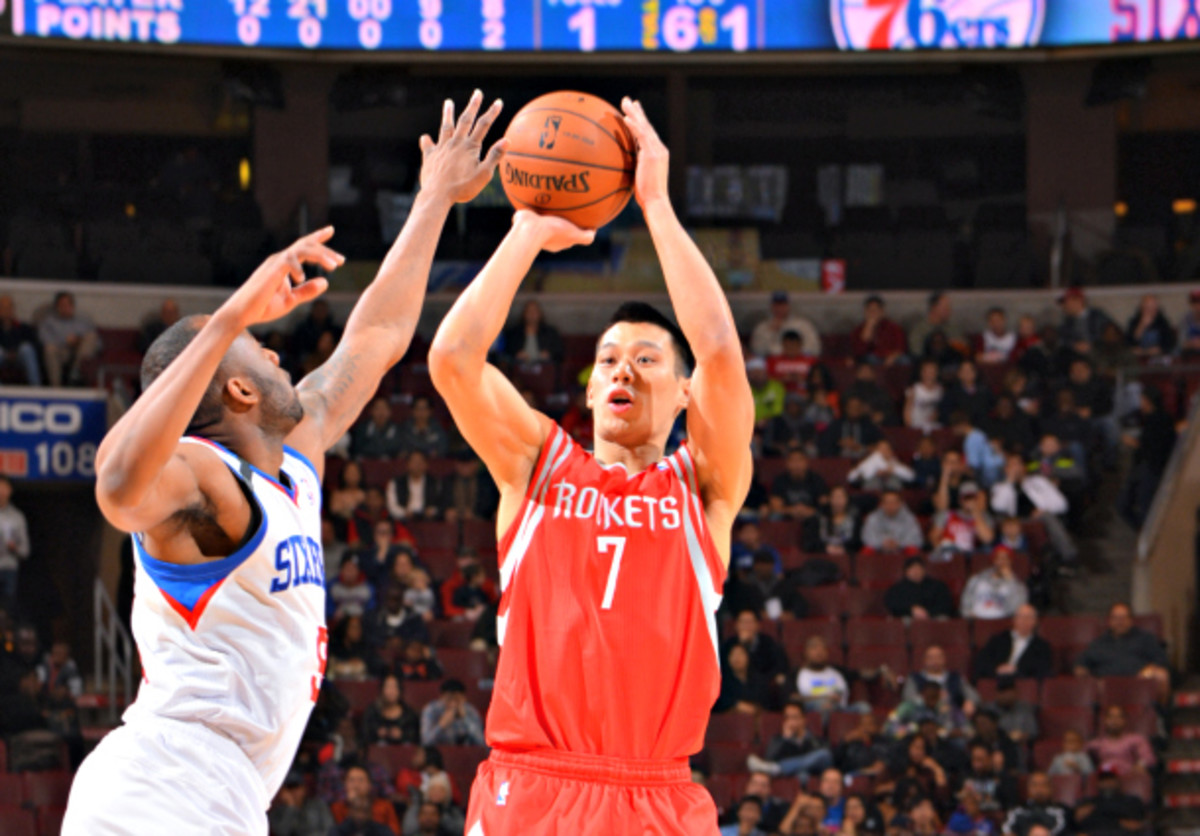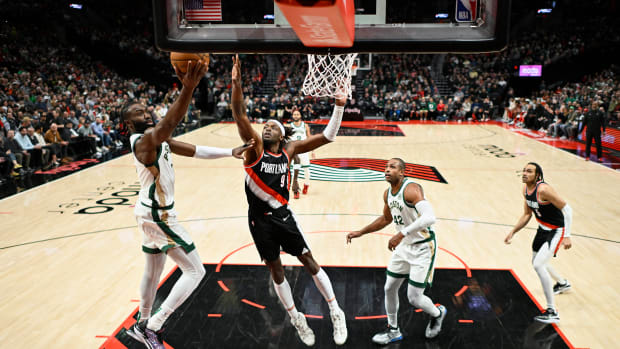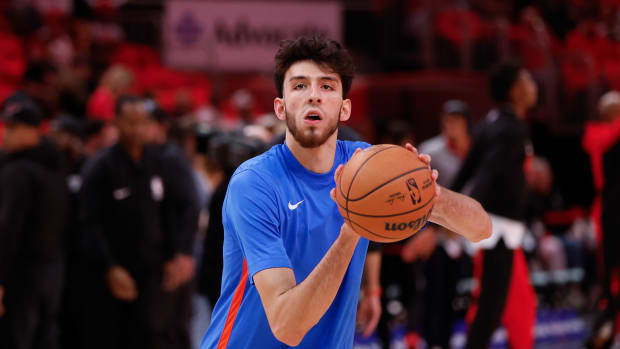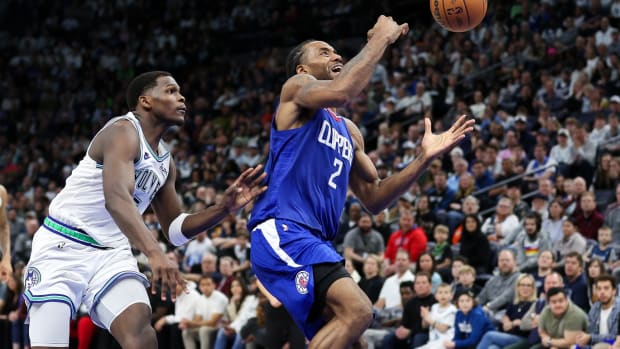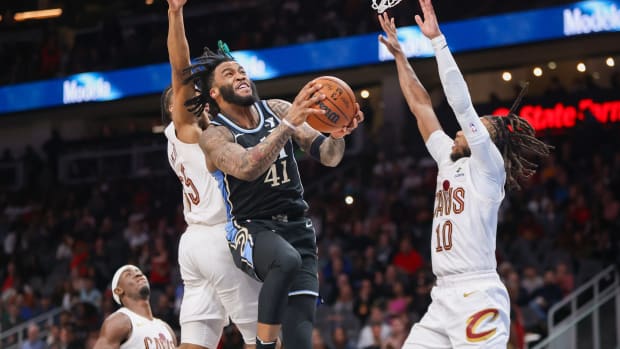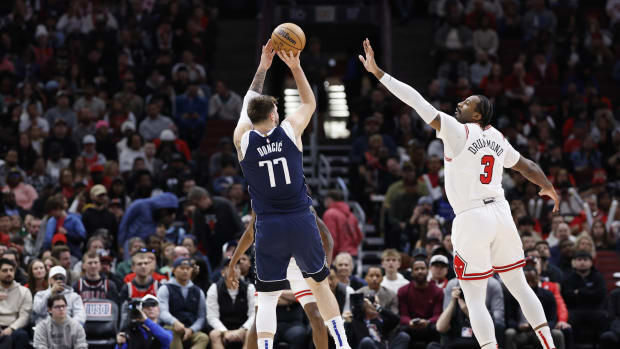Taking aim: Which NBA players have expanded their range this season?
Jeremy Lin has dramatically improved his long-range shooting this season. (Jesse D. Garrabrant/NBAE via Getty Images)
Shooting is a craft. It requires repetition and discipline above all else, as technical precision pales in importance relative to pure muscle memory. It's an art honed through hours upon hours of work, and more than perhaps any other pertinent basketball skill, can be learned. Shooters are grown, not born, a difference that inspires players across the league to focus their offseason efforts on that which can be groomed through practice. All it takes is a ball, a hoop and tens of thousands of jump shots.
Each fall a host of NBA players return to their teams boasting of expanded range. Some aspired to be better on intermediate jumpers. Others have worked on situational specifics, like pull-ups or fadeaways. Yet most honed in on the three-pointer -- the sexiest and most efficient of ranged attempts, and one that can expand a player's value dramatically in a league that so values spacing. It's early still, but there are enough attempts on the books to examine the first returns of those newfound shooters, and analyze the trends in their improved shooting percentages or dialed up attempts.
Jeremy Lin, Houston Rockets
2012-13: 3.1 3PA per game, 33.9 3PT%
2013-14: 4.3 3PA per game, 46.5 3PT%
Forget the scouting report. Jeremy Lin has used hard work and a hot hand to incinerate expectations of his long-range shooting thus far, in ways both expected and surprising. As far as the former, it's no surprise there would be plenty of opportunities like this one with Dwight Howard's arrival in Houston:
Note: With these interactive still shots, hover over the target icons to view the relevant explanation as captions. To watch the full video of the play, click the overlaying play button.
The defense collapses, the ball kicks out, and Lin -- whether by convenience or defensive choice -- often is the recipient of a wide-open look. Still, it's the extent to which Lin has made the most of his opportunities thus far that's been stunning. After converting just 34.6 percent of his spot-up three-pointers a season ago, Lin has made 56.5 percent of similar shot attempts through 10 games this season. His shooting form remains the same, but that slightly cleaner look and slightly longer window seem to have parked Lin in his comfort zone.
Lin's shooting percentages will likely drift downward as the sample size stretches; his current conversion rate is just too exceptionally high to expect their season-long endurance. Still, it also seems clear that Lin's summer of shooting has paid off, as he's come out of the gate confident and connecting.
2012-13: 0.9 3PA per game, 26.7 3PT%
2013-14: 4.3 3PA per game, 35.3 3PT%
Wall hasn't merely been an inconsistent shooter since coming into the NBA, but a conclusively poor one. It's to his great credit that he seemed to grasp his limitation rather quickly; after averaging nearly two long-range attempts per game in his rookie season, Wall dialed down the threes over his next two years as he focused his efforts within the arc. Now, after a few years of work in stretching out his range, Wall finally seems ready to contribute as a shooter -- having improved a prior 24.3-percent career three-point shooting mark to 35.3 percent in eight games this season. He's as shaky as ever off the dribble, but Wall has already converted 8-of-15 threes this season when given a chance to set his feet, per Synergy Sports. That he's such a poor shooter off the bounce is unfortunate given how often he insists on taking those shots, though at the least Wall is now better equipped to contribute as a spot-up threat when the ball isn't in his hands.
Paul Millsap, Atlanta Hawks
2012-13: 0.5 3PA per game, 33.3 3PT%
2013-14: 1.6 3PA per game, 38.5 3PT%
Millsap has wandered outside in previous seasons to hit the occasional three, but has never before attempted long-range shots with such consistent frequency. It's a natural progression; after consistently registering shooting percentages in the low-to-mid 40s on his longer two-point attempts, it was only a matter of time before Millsap took a step back to cash in on the extra point and heightened floor spacing that comes with life beyond the arc. The primary vehicle for those attempts has been the pick-and-roll, albeit with Millsap out of the direct action as a floor-spacing shooter:
It should also be noted that Millsap has been significantly better from some zones than others, with straight-ahead looks from the top of the key serving as his worst (0-for-5) by far to date. Standstill shooting from the left wing, though, has yielded pretty impressive returns (4-of-5) in a limited sample.
Wesley Johnson, Los Angeles Lakers
2012-13: 3.1 3PA per game, 32.3 3PT%
2013-14: 3.5 3PA per game, 40.0 3PT%
On draft day, Johnson's appeal was that of an athletic, floor-stretching big -- a positional bender who could open things up for the offense by drawing defenders out of the paint and blowing by them off the dribble. None of those hopes manifested during Johnson's dreary stints in Minnesota and Phoenix, though he's found a spark with the Lakers by hitting a cool 50 percent of his spot-up tries this season, per Synergy Sports. Johnson might be a bit quick to fire in some instances, though his release is fast enough -- and his release point high enough -- to avoid pressure from most closeouts. Johnson's shooting mark has some room for improvement; he's been spending lots of time in the strong side corner as the Lakers run pick-and-rolls, and to date hasn't had much luck in converting the quality looks that result. That could wind up as another weapon for a player looking to reclaim his perimeter touch, though Johnson's jumper deserves little benefit of the doubt when it comes to staying power.
Amir Johnson, Toronto Raptors
2012-13: 0.2 3PA per game, 38.5 3PT%
2013-14: 1.7 3PA per game, 33.3 3PT%
Johnson has been patiently building out his shooting range in recent seasons and toying around with a set shot three-pointer in practices and warm-ups for some time. He used it selectively last season, converting 5 of 13 attempts. Just nine games into this season, Johnson has already eclipsed that long-range shooting volume; so far Johnson has found occasion to hoist up almost two long-range attempts per game, largely because opponents haven't yet shown any inclination to defend him from that range.
It's all for the best, as Johnson's shot has a long windup that demands a sizable window to properly unfurl. It isn't pretty -- Johnson caps off his shot with a stunted release with almost no follow-through whatsoever -- but it could soon be accurate enough to punish defense for leaving Johnson wide open.
Marvin Williams, Utah Jazz
2012-13: 2.3 3PA per game, 32.5 3PT%
2013-14: 2.8 3PA per game, 40.0 3PT%
Williams was irrelevant beyond the arc in his early career, though in recent seasons he has managed to hit with enough frequency on his long-range tries to at least register with opposing defenses. Still, Williams has had but a single above-average three-point shooting season since 2009, furthering his range-less reputation. Thus far this season, Williams has bucked the trend; while he hasn't been very successful from the corners, Williams has been capitalizing on his attempts from the wing at a 40-percent clip. He does a nice job of floating out to wing to clear out of the way of a play in progress, and with that presents Utah's ball handlers with an easy kick-out option when things inevitably go awry. It remains to be seen whether Williams can really sustain this kind of shooting, though there's hope in the fact that he's often left unattended and has good balance on his jumper.
P.J. Tucker, Phoenix Suns
2012-13: 0.9 3PA per game, 31.4 3PT%
2013-14: 2.3 3PA per game, 50.0 3PT%
Tucker was a fine role player for the Suns last season, though he wasn't a three-point threat in the slightest. He defended, hustled for rebounds and scrounged up points, never stepping outside himself and rarely stepping beyond the arc. Yet stretching out to three-point range was clearly a priority for Tucker, if only to make him a respectable option from the corners -- a bit of real estate responsible for every one of his three-point attempts this season. He's even found refuge there in transition:
For an unremarkable athlete like Tucker, the flexibility to veer out to the three-point line on the break is a blessing. He can dart toward the basket and do fairly well, but in wading out to the corner Tucker opens up a high-value look and plenty of driving room for the Suns' aggressive lead guards. The same goes in the half court, where Tucker spaces the floor in a way he couldn't last season. Eric Bledsoe, Goran Dragic and Ish Smith are undoubtedly thankful, as they have either an easy target or a clearer path to the basket thanks to Tucker's stretchier game.
There are, of course, those who have ramped up their three-point shooting frequency without the same success. Just to name a few:
Patrick Patterson, Sacramento Kings
2012-13: 1.9 3PA per game, 38.6 3PT%
2013-14: 3.0 3PA per game, 19.0 3PT%
Patterson began his flirtation with the three-point line last year, finding particular success there after his mid-season trade to the Kings. From that, Patterson appeared poised to be the reliable, floor-spacing complement that DeMarcus Cousins needs and a helpful decongestant for the Kings' offense in general. That aim hasn't quite gone as planned; while Patterson might be utilized more consistently as a three-point option, his percentage has tanked with the growing pains of expanding range. As one might expect of a player stretching back to the three-point line with a set shot, Patterson's attempts come up consistently short. He has the foundation to solidify his long-range shooting in time, though his three-point accuracy last season may have been an early blip in a longer process.
2012-13: 0.0 3PA per game, 0.0 3PT%
2013-14: 1.3 3PA per game, 11.1 3PT%
Scott is more or less an extension of Millsap, in that he's used to help balance the floor as other players run pick-and-rolls. He's managed a few three-point attempts off of his own screens, but -- as his percentage suggests -- he still has a long way to go. It says something that a mid-range specialist is now confident enough to fire away from deep, though it seems fairly obvious at this stage that Scott just doesn't have the requisite range.
Serge Ibaka, Oklahoma City Thunder
2012-13: 0.7 3PA per game, 35.1 3PT%
2013-14: 1.0 3PA per game, 25.0 3PT%
As Ibaka's face-up game has grown, so too has his interest in the corner three. He's still working out the kinks; Ibaka tends to gravitate toward the left corner even though he's far more accurate from the right; in truth, his location beyond the arc this year has hardly mattered. Ibaka's attempts to shoot the occasional three is more notable for narrative than basketball strategy. It's a sidebar on any handwringing story over the Thunder's offensive spacing, and a means of removing him from the same areas of the floor as Kendrick Perkins. Yet opponents really haven't shown any interest in venturing outside to guard him, nor should they:
Even though Ibaka will make the odd three-pointer, Minnesota's Kevin Love makes the smart play there: Gravitate toward either Kevin Durant or Russell Westbrook when they attack, recover to Ibaka as you can, and live with the results.
Andrew Nicholson, Orlando Magic
2012-13: 0.0 3PA per game, --- 3PT%
2013-14: 2.0 3PA per game, 22.2 3PT%






























